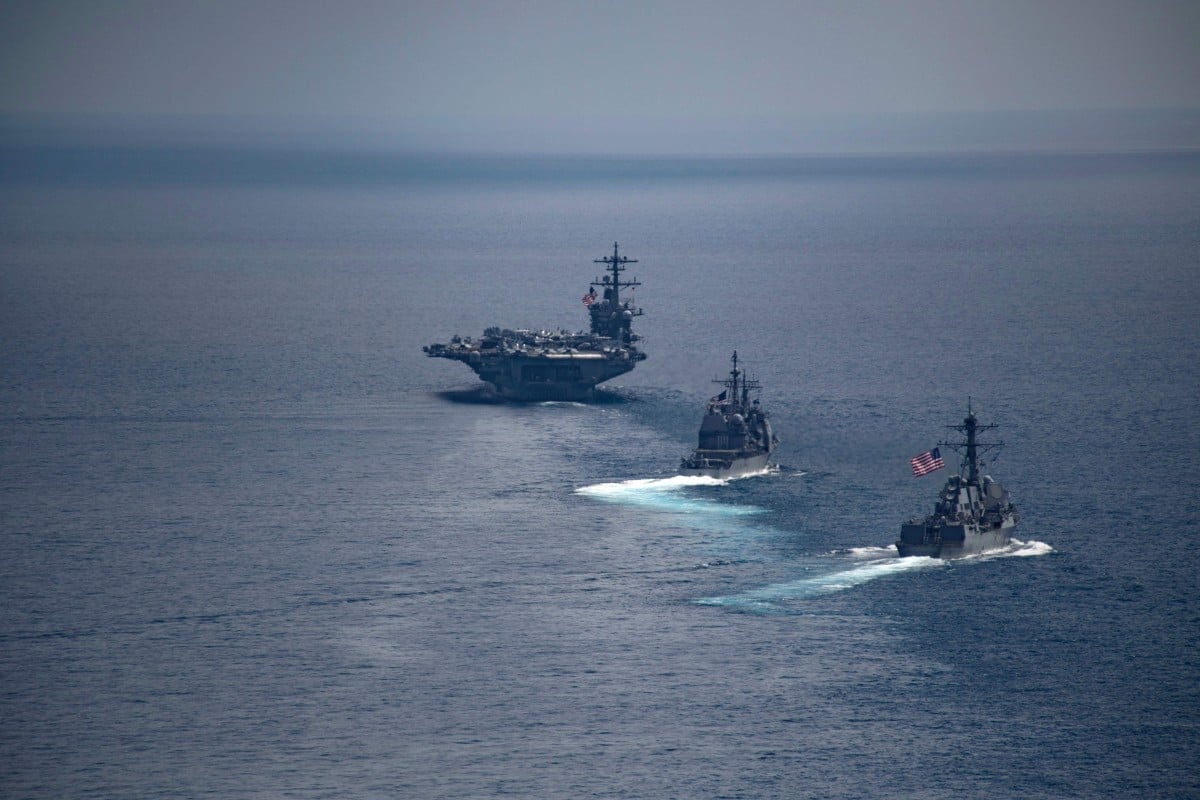Kristin Huang

A proposed new US Navy fleet in the Indo-Pacific could pose a threat to China’s growing interests in the region as it would cover key trade routes, according to a military analyst.
US Secretary of the Navy Kenneth Braithwaite
made the call on Tuesday, saying he was looking to establish a new First Fleet “in the crossroads between the Indian and the Pacific oceans”, in an address to the Naval Submarine League’s annual symposium.
It came a day before the United States, India, Australia and Japan held the second phase of a naval drill in the Northern Arabian Sea, seen as part of a regional initiative to counter China’s growing assertiveness in the Indo-Pacific.
“We can’t just rely on the Seventh Fleet in Japan. We have to look to our other allies and partners like Singapore, like India, and actually put a numbered fleet where it would be extremely relevant if, God forbid, we were to ever to get in any kind of a dust-up,” Braithwaite was quoted as saying by military website USNI News.
Braithwaite, the US Navy’s top civilian leader, said he had not discussed the plan with new acting defence secretary Christopher Miller, but had done so with Mark Esper, the Pentagon chief who was fired by President Donald Trump last week.

Kenneth Braithwaite said he had not discussed the plan with the new acting defence secretary. Photo: Handout
The Indian Ocean is a critical link in global trade routes, with 80 per cent of seaborne trade passing through it. Eighty per cent of China’s oil imports pass through the Malacca Strait, the Indian Ocean’s busiest choke point, according to an analysis by the Mercator Institute for China Studies.
A new US fleet focused on the Indian Ocean could be a problem for China’s ambitions in the region, said Song Zhongping, a former instructor with the People’s Liberation Army’s Second Artillery Corps.
“China relies a lot more on the Indian Ocean than the Western Pacific,” he said. “Setting up a US Navy fleet would be akin to grabbing China by the throat – it would hurt China’s development interests in terms of energy supply chains and investments in belt and road projects.”
Beijing’s controversial Belt and Road Initiative is a vast infrastructure investment scheme that aims to link China with Asia, Africa, Europe and beyond.
Under the initiative, China has partnered with Indian Ocean countries including Pakistan to build key infrastructure projects such as highways and ports, in an apparent attempt to get faster access to Europe and Africa.
The Pakistani port of Gwadar, for example, built and managed by a Chinese consortium, is strategically located near the Strait of Hormuz, the world’s most important sea route for oil.
Timothy Heath, a senior international defence research analyst with US think tank Rand, said the US could easily set up the new fleet, but it may be a challenge to build it up.
“The US naval fleet has shrunk considerably over time and already faces challenges in meeting the duties of existing commands,” Heath said. “Most likely, the new command would probably operate with a small number of ships, at least initially.”
Charlie Lyons Jones, a researcher from the Australian Strategic Policy Institute’s defence and strategy programme, said the move would be welcomed by US allies such as Australia, which may be willing to host an additional American naval facility.
“But there are legitimate concerns that the establishment of a First Fleet based in the Indian Ocean has been a little haphazard and was done without much consultation with allies,” Lyons Jones said.
“Furthermore, it would be nice to see the US Navy procure more ships and increase its tonnage before establishing a fleet dedicated to the Indian Ocean, as the US Seventh Fleet is currently stretched and its leadership would be justifiably unwilling to let go of much-needed resources in the Pacific.”
The US Navy’s Seventh Fleet at Yokosuka in Japan covers a massive area of 48 million square miles, stretching from the international date line in the mid-Pacific to the India-Pakistan border in the Indian Ocean. The Fifth Fleet, based out of Bahrain, covers the Middle East and the western Indian Ocean.
The US has stepped up its presence in the Indian Ocean since Trump introduced his Indo-Pacific strategy in 2017. Trump also revived the Quad security grouping that year, pushing for closer ties with the other members, Japan, Australia and India, through military drills.
But according to Lyons Johns, the grouping is more about “collaborative defence”.
“[It] seeks merely to secure an Indo-Pacific that is free from authoritarian coercion and open to international trade,” he said. “Therefore, it doesn’t seek to ‘take the lead’ in countering China if there ever happens to be a military conflict between China and the United States.
“Rather, it seeks to prevent such a conflict from occurring in the first place.”
No comments:
Post a Comment